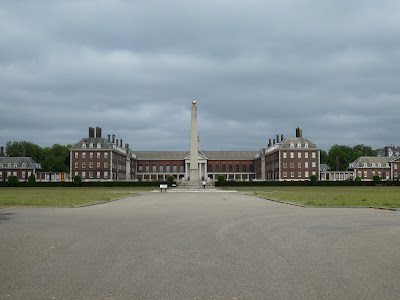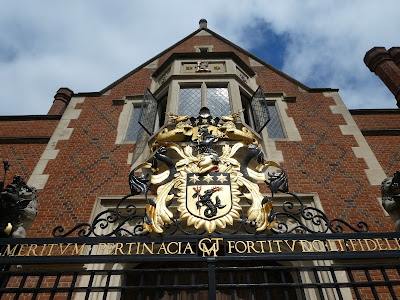"I don't want to go to Chelsea" Elvis Costello famously sang. (Well, "nasally intoned" might be a better description given Elvis' limited vocal abilities.)
But I did want to go, so set off for a long walk, starting at Sloane Square tube station, which is right next to the Royal Court Theatre.
This is typical of the side streets around here - elaborate Victorian terraces.
They went to town on the roof decoration.
But what is Chelsea most famous for (well apart from the football team)? Yes, Chelsea pensioners in the Royal Hospital Chelsea.
In normal times I could have wandered around the hospital as it is open to the public. But these are not normal times, and residences packed with pensioners are not the ideal place in a pandemic to invite visitors. So, all the gates were shut, and I was left to take photos of Wren's masterpiece through the railings.
The story goes that Charles II's mistress Nell Gwynn was so sad at seeing destitute ex-soldiers and sailors on the streets of London that she prevailed upon Charles to sponsor this hospital for soldiers and Greenwich for sailors. Whatever, it has left us with two beautiful, restrained buildings, and of course Chelsea still is home to retired soldiers over 300 years later. I think it is a fair testament to its design, that it remains in use (and demand) for its original purpose, in an age when many award winning buildings are found to be no use for their purpose within only a few decades, if that.
I love the statue of the Chelsea Pensioner
This is the Hospital from the Thames-side view
This is the Chillianwallah Memorial obelisk, celebrating a victory in battle against the Sikhs in 1853. I am half surprised no one has tried to topple it as being offensive, except I guess the Sikhs aren't black so their lives don't matter enough, and protesters are probably not strong enough to do it any damage, nor brave enough to take on a Chelsea pensioner with a walking stick.
Going down Tite Street one finds a terrace of respectable red Victorian houses, with a very disrespectable former resident, poor Oscar Wilde. At least he is vastly better remembered now than any of his persecutors.
The view across the Thames. As you can see at this point the weather was very overcast, which sadly coincided with a partial eclipse. Evidently if you can't see the sun a partial eclipse doesn't show up much.
Below is the Chelsea Physic Garden. This was closed because it only opens afternoons, although maybe it was closed due to Covid too. It was established as long ago as 1673 by the Worshipful Company of Apothecaries to grow medicinal plants.
Now I proceeded along Cheyne Walk, a road that is positively covered with blue plaques. I commented in my last entry that Notting Hill has surprisingly few. Well Chelsea has loads, as it was a particularly popular area with the Bohemian set, so memorials of creative types abound.
Built just between the Walk and the Thames is the Embankment Gardens, the Embankment having been created to on the side of the Thames to take sewers beneath (rather than the Thames just being used a sewer). So there is a nice little sliver of greenery between the big houses and the modern banks of the Thames, which was narrowed to about 700 feet from its natural banks to accommodate the Embankment, and here we come across the first arty resident, the composer Ralph Vaughan Williams.
This fine five storey dwelling was home to the novelist George Eliot, author of Mill on the Floss.
This narrow house was once home to the eccentric Pre-Raphaelite artist Dante Gabriel Rossetti. He apparently kept both a zebra and a kangaroo here, as well as the flagellation loving poet Algernon Swinburne. You can't really beat that for eccentricity.
And the painter James McNeill Whistler was neighbour.
One could easily miss this interesting little plaque.
This curiously modern yet dated sculpture (and the offices behind) breaks up the run of pre 20th century houses
This pair of tall houses was built in 1899 by the Arts & Crafts designer Charles Robert Ashbee, just to add to the eclectic mix.
A statue of Thomas Carlyle, a Scottish writer and historian who was much admired in the 19th century but rather dropped off the modern radar. But nice statue with an impressive likeness.
Cutting in from Cheyne Walk you find Cheyne Row, one of many sweet little streets around here, not built up quite as high as the houses on the Thames frontage.
This is Thomas Carlyle's House, now a museum owned by the National Trust.
And this harps back to the days when there was actual industry in this posh part of town. Chelsea porcelain is much collected, but the manufacture moved to Derby and the "factories" were demolished to make way for all these houses. In the 18th century many of our nascent industries (including textiles and metal working) were carried out in extended houses rather than purpose built factories.
And why are there no great English names like Tobias Smollet any more? If you have never heard of him, well his best known work was the Adventures of Peregrine Pickle. Really.
This plaque (and many similar) are on the side of Carlyle Mansions - smart Victorian apartments once home to Ian Fleming, Henry James and TS Eliot.
This is Chelsea Old Church. It actually dates back to 1157 when Chelsea was a fishing village, but if it looks a bit too "new" for that, most of the church was destroyed in the Blitz and had to be rebuilt. But it has a most attractive, crowded little courtyard with old memorials. I had it to myself.
The memorial to Sir Hans Sloane interested me as much for the fact it records he died at the venerable age of 92. Not everyone in the 18th century had an early death due to disease.
At the front of the church there is a rather austere statue of Sir Thomas More, Henry VIII's Lord Chancellor. He was also a lawyer, philosopher, statesman, writer and saint - in the days when you didn't tend to specialise! (I can't somehow see Boris getting "saint" added to his CV)
Next to the church are the modern and very small Roper's Gardens.
The little bit of roof line you can see below was part of Lindsey House, built in 1674 for the 3rd Earl of Lindsey, but now houses and flats behind gates which make sure you can't see in at all. Chelsea was once the "village of palaces" after both Henry VIII and Sir Thomas More built mansions out here in the sticks. So other aristocrats followed suit. The mansions almost all were demolished to make way for high density housing.
As I say, the area is not short of blue plaques, especially for artists. I recognize the painter Philip Wilson Steer, but not his neighbouring sculptor.
But you don't get a bigger name in the 19th century art world than Joseph Mallord William Turner. He odes deserve more than blue disc.
Back on the Thames itself is another modern little park, Cremorne Gardens. They are not impressive, but they used to be part of a much larger (and no doubt more attractive) set of pleasure gardens.
Standing rather weirdly right in the centre are a pair of very grand gates that once formed the entrance to the pleasure gardens, but now stand isolated and purposeless just in the middle.














































































































No comments:
Post a Comment